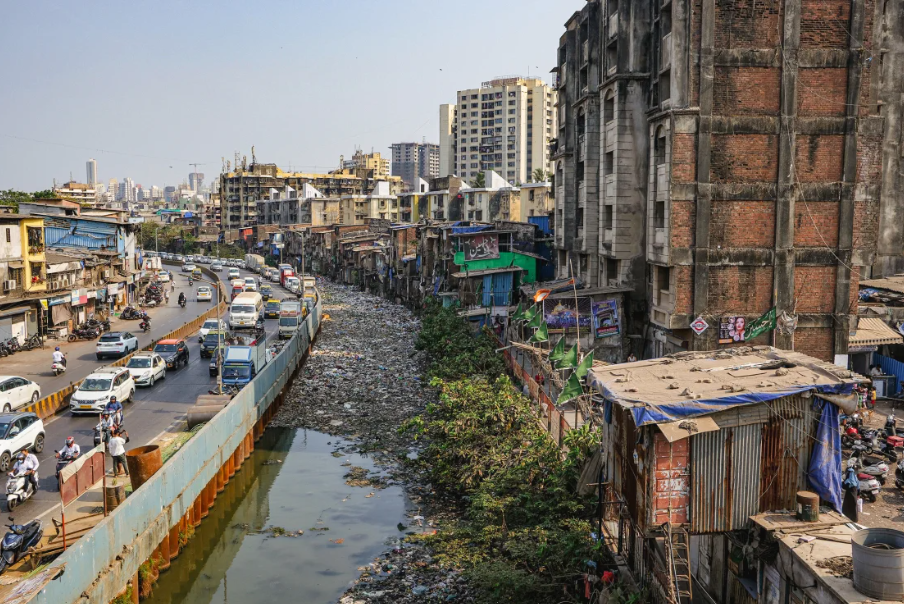Gautam Adani, whose wealth has surpassed that of Jeff Bezos, plans to redevelop Dharavi, India’s largest slum. However, residents are protesting the project out of fear for their jobs.
When Masoom Ali Shaikh arrived in Mumbai in 1974, the area where he opened his business was just barren land. Today, Dharavi is one of Asia’s largest slums and a vibrant industrial hub. These businesses, ranging from bakeries to butcher shops, are essential for the survival of families, many of whom have lived in the slum for generations. Shaikh, who moved to Dharavi from Uttar Pradesh, has been able to support his family and even open a second shoe store for his daughter.
Many residents of Dharavi are concerned about the drastic reforms planned for the slum, which are now under the oversight of Gautam Adani, one of Asia’s richest men. Historically, previous attempts to redevelop the area have been complicated by political issues and the high valuation of land in central Mumbai.

Dharavi faces serious issues such as overcrowding and inadequate sanitation, with many residents lacking access to clean water and proper toilets. Air pollution is also a concern, compounded by constant dust and smoke from nearby workshops.
Gautam Adani has promised to transform Dharavi into a “world-class city” that symbolizes a growing and confident India. However, the proposal has elicited mixed reactions among residents. While some are hopeful for change, others remain skeptical, recalling unfulfilled promises from the past.
For over a century, Dharavi has been a refuge for migrants attracted by the unregulated land. Since the late 19th century, the slum has been shaped by various industries, from potters from Gujarat to leather workers and tailors from other regions of India. Dharavi’s growth mirrors that of Mumbai, drawing aspirants for Bollywood and workers from across the country.
Lalitha Kamath, a professor of urban planning, notes that migrants often occupy “marginal” areas deemed unsafe or uninhabitable. In Dharavi, these residents have transformed swampy terrain into a highly valuable area. Yet, the slum remained underdeveloped and disorganized until basic improvements were made in the 1970s, such as the construction of roads, drainage systems, and the provision of water and electricity.
The redevelopment of Dharavi presents a significant challenge due to its size, economy, and valuable location. The government has struggled to find developers capable of undertaking the complex and costly task of revamping the area. Issues such as the relocation of residents, compensation for business owners, and eligibility criteria for beneficiaries remain unresolved. Adani has promised to relocate about a million people, rebuild housing and businesses, and provide better health, recreational, and educational facilities, including a hospital and a school. Residents who cannot be relocated within Dharavi will be given resettlement options.
However, some residents, like Dilip Gabekar, express distrust. Gabekar, who works for a nonprofit and is 60 years old, points out that development promises have been made over decades without tangible results. He notes that reform is often mentioned during election campaigns, but discussions fade afterward.
Baburao Mane, a former member of the state assembly and a local from Dharavi, has led protests against Adani’s plan, including a major rally in December where thousands marched to Adani’s offices in Mumbai. Mane claims that only about 50,000 residents of Dharavi, roughly 5% of the population, have valid documents, fearing that the ongoing survey could further reduce this number.
Mane criticized the project’s approach, arguing that housing allocations should not depend on valid documents but should ensure that anyone who owns land in Dharavi receives a place during development. In response, a spokesperson for the Dharavi Redevelopment Project Private Ltd (DRPPL) assured that the plan includes “appropriate compensation mechanisms” to address concerns about residents’ eligibility.
Despite the concerns and resistance, there is a consensus among residents that Dharavi needs reform. Some citizens, like potter Dhanshuk Purshottamwala, enthusiastically support Adani’s plan. Purshottamwala, whose family has lived and worked in Dharavi for generations, views the reform as an opportunity for his children to have a better life and to move beyond the family tradition of pottery.
While the redevelopment of Dharavi presents a massive challenge, Gautam Adani is involved in some of India’s largest infrastructure projects. He is the largest operator of airports in the country, controls the biggest private port operator, and the largest private coal power producer, and is building the world’s largest clean power plant.
However, Adani is relatively new to slum and social housing development. Lalitha Kamath notes that the lack of affordable housing has led to the emergence of informal settlements like Dharavi. Many residents express distrust towards Adani’s conglomerate and the city administration, heightened by allegations of fraud against the Adani Group in 2023, which led to an investigation and a loss of over $100 billion in market value. Despite a court order to expedite the investigation’s conclusion, Adani has faced criticism regarding the allegations, which his representatives claim are unfounded.
Furthermore, residents complain about a lack of transparency in the reform process, with little official communication and exclusion from meetings about the plan, leaving them without information on details and timelines. Kamath points out that such projects are often carried out in a top-down manner, with decisions made by a small group of developers and government officials, leaving communities with little influence.
Distrust of the Dharavi redevelopment project is not limited to transparency and unfulfilled promises. There are broader concerns about how such projects often fail to adequately consider all stakeholders who have contributed to the formation and development of the reformed areas, as Kamath observes.
Additionally, there is an ongoing lawsuit in which a competing company claims that the Maharashtra state government unlawfully annulled and restarted an original tender process from 2018 to allow Adani to win. Both the state government and Adani deny any irregularities. However, many residents remain skeptical of the connections between Adani and the government, exacerbated by Adani’s public support for Prime Minister Narendra Modi and allegations that opposition leaders were punished for questioning the relationship.
A spokesperson for DRPPL stated that Adani won the tender in an “open, transparent, fair, and competitive” manner and that the allegations of political connections are “unfounded and aimed at spreading disinformation.”
Meanwhile, residents like Reshma Prasant Bobde, a 42-year-old housewife whose family has lived in Dharavi for generations, express frustration over the constant repetition of development promises that never materialize. Bobde describes an endless cycle of politicians presenting reconstruction plans to promote their agendas, followed by protests and stagnation. She fears that nothing will change in Dharavi, not even for her children.

